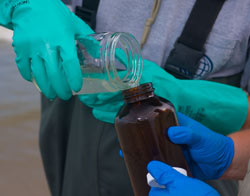Nursing News and Information
The FDA has pulled Darvon and the related brand Darvocet from the marketplace. In addition, the FDA ordered generic drug makers to discontinue making drugs containing propoxyphene - the active ingredient in Darvon. Britain outlawed Darvon in 2005 and the European Union outlawed Darvon in 2009. The FDA pulled the drug based on new research showing that it leads to heart arrhythmias. Other side effects such as increased suicidal rates and accidental overdoses were instrumental in the European Union’s banning of the drug. Propoxyphene is also noted for its high death rate associated with intake. The death rate for patients taking propoxyphene is 16 deaths per 100,000 prescriptions.
The initial requests to remove propoxyphene were submitted to the FDA in 1978. The FDA took no action at that time citing that the benefits of the drug outweighed its risks. In January 2009, the FDA voted 14 to 12 in committee to discontinue propoxyphene products in the marketplace. In July 2009, the FDA changed its decision and allowed propoxyphene to continue in the marketplace but with increased warning label requirements.
The FDA notes that recent research shows that even when taking normal dosages of propoxyphene the drug causes “significant changes to electrical activity of the heart.” These changes show up in ECG (electrocardiogram) tests and propoxyphene is linked to a high risk rate for “serious abnormal heart rhythms.”

The EPA (Environmental Protection Agency) and the Department of Transportation (DOT) will phase in the first ever greenhouse gas and fuel efficiency standards for trucks and buses. The programs begins in 2014 and gradually increases fuel economy and emissions standards over several years. It is estimated to reduce greenhouse gas emissions by 250 million metric tons and save 500 million barrels of oil over the lives of the vehicles manufactured in the first five years of the program.
US Transportation Secretary Ray LaHood notes, “Through new fuel-efficiency standards for trucks and buses, we will not only reduce transportation’s environmental impact, we’ll reduce the cost of transporting freight.” He also commented that this is an example of benefiting consumers, business, and the environment simultaneously. The NHTSA and EPA note that a semi truck operator will save approximately $74,000 over the life of the vehicle as a result of higher mileage standards.
The National Highway Traffic Safety Administration (NHTSA), a division of DOT, proposes to increase mileage and emission standards for combination tractors, heavy-duty pickups and vans, and vocational vehicles. Manufacturers will use several types of technological solutions to meet the more stringent standards. Vehicles will get engine and transmission upgrades and will also have improved aerodynamics and tire rolling resistance. The total benefit to businesses and consumers in cost savings is estimated at $41 billion between 2014 and 2018.
Improvements in air quality and the impact on public health were not included in the estimates. Improved air quality as a result of stringent vehicle emissions standards reduces the health impact on Americans. Doctors, nurses, acupuncturists, and all health care professionals treat many disorders such as COPD, asthma, and cancer that are more prevalent with increased airborne carcinogens and pollutants. Reduced vehicle emissions and the associated improvements in air quality will ease the health impact of hydrocarbon related health hazards on hospitals and insurance costs. Moreover, better mileage for trucks and buses will ease financial burdens on businesses burdened by fuel costs.

The 1986 National Childhood Vaccine Injury Act, passed by Congress, holds that vaccine manufacturers cannot be held liable for injuries due to vaccine side effects except in cases of manufacturing defects and improper warning claims (marketing defects). That much is agreed by the plaintiff and the drug manufacturer in the case of Bruesewitz v. Wyeth before the Supreme Court. The Obama Administration, siding with the pharmaceutical industry in this lawsuit, was represented in the Supreme Court by Mr. Horvich, Assistant to the Solicitor General, Department of Justice.
What is in question is whether or not ‘design defect claims’ are submissible in State courts, outside of the Vaccine Court system set up by the federal government. Design defects are those inherent in the design of a product unlike manufacturing defects which are accidental production errors. At question is whether or not a pharmaceutical company is liable if they are aware of a better designed vaccination (one with fewer side effects) yet continue to use the less safe vaccination. The less safe vaccination is thereby defective by design.
The National Childhood Vaccine Injury Act expressly protects manufacturers from being sued in an effort to incentivize manufacturers to produce vaccines without fear of lawsuits. Congress has also created the federal Vaccine Court system to provide compensation for vaccine injured persons from the money generated by a tax on vaccine manufacturers.
The parents of Hannah Bruesewtiz were denied compensation in the Vaccine Court system and now seek compensation through State court. Six month old Hannah received a DPT (diphtheria, pertussis, tetanus) vaccination and immediately suffered a series of 125 seizures over a period of 16 days. Now 18 years of age, Hannah cannot speak or care for herself as a result of her injuries. The vaccine used on Hannah has since been discontinued in favor of safer alternatives.
Before the Supreme Court, attorneys for the Bruesewitz family argue that safer alternatives were available at the time Hannah received her vaccine and that the manufacturer had the responsibility of providing the safer alternative and at the very least had the responsibility of providing labeling noting that a safer alternative is available. Mr. Frederick, attorney for the plaintiff argues, “for many vaccines there is no safer alternative, and there could be no design defect claim. But for those instances in which there is a safer alternative, the burden under State law is for the manufacturer to act reasonably in pursuing the safer design, if that is available.” Mr. Frederick added that there will not be excessive lawsuits as a result of a verdict in favor of the Bruesewitz family since the Vaccine Court system already handles all cases except rare exceptions such as this.
Justice Ginsburg showed deep concern when questioning Mr. Horvich of the Obama Administration, “there were an unusual number of adverse reactions to the particular lot that this child's third vaccine came from, and that those adverse reactions were not disclosed to the doctors. And the doctors -- the child's doctor said if I had known about the unusual number of adverse reactions, I never would have used this vaccine.”
Chief Justice Roberts Agrees with Justice Sotomayor
The Supreme Court Justices seemed concerned that design defects were disallowed as a reason to sue in the court system as a result of prior rulings in this case. Justice Sotomayor asked pointedly of Ms. Sullivan, attorney for the pharmaceutical company Pfizer, Inc. (now owner of Wyeth), “Point me to the FDA regulations or law where the FDA, in giving a license to or permitting a new vaccine, actually looks at whether that vaccine is the most efficacious way with the least serious harm to the population. Is there a regulation that requires that judgment by them before they issue permission to market?” Ms. Sullivan replied, “There is not, Justice Sotomayor.” Justice Sotomayor responds, “All right. What is the motivation? If there is no -- there's no approval mechanism for the FDA to look at that issue, what is the motivation for manufacturers to voluntarily remove a drug that is causing harm to the public before the FDA acts? If they are completely immune under your reading of this preemption statute, what motivates them to act more quickly?” The drug company lawyer did not respond with an answer. Justice Sotomayor continued, “Could you please just answer that question? What is the motivation for the manufacturer to either continue the testing of their product and voluntarily stopping it if a better design has been found by someone else or even an inducement for them to find a better design if a competitor comes around? Because I don't see why they should stop until they have caused as many injuries as they need to before the FDA says stop.” Once again, Ms. Sullivan did not answer the question only to be probed by Chief Justice Roberts, “Before you get to that, I think your answer to Justice Sotomayor's question is: Nothing; the manufacturers have no reason to take the vaccine off the market until the FDA tells them to.”
The Court is Stunned
In the following argument, Justice Kennedy is concerned that the pharmaceutical company attorney asserts that the drug company need never inform the government of safer vaccines and that the consumer may not sue on the basis of the drug company intentionally withholding drug safety information. Justice Kennedy asked, “But if the manufacturer is slow or remiss or negligent or willful in not giving the information to the Government, there is nothing the injured person can do. There is still complete preemption, under your view?” The drug company attorney replied, “Of design defect claims, Justice Kennedy, but not of warning claims.” Justice Kennedy replied, “The warning doesn't have to say, 'Warning: We could make something better if we wanted to'." The court then erupted in laughter.
Avoidable Harm vs. Unavoidable Harm Protection
Justice Breyer then noted that the1986 National Childhood Vaccine Injury Act legally protects drug companies from lawsuits due to unavoidable harm (such as side effects from vaccinations) but that the drug company lawyers are now suggesting that they are also protected from avoidable harm lawsuits. Avoidable harm includes withholding information from the government and the public concerning safer vaccines and also not informing doctors and nurses of high incidences of reactions to particular batches of vaccines. The attorney for the drug company replied that if manufacturers were to be sued for avoidable harm they would be “driven from the market” and she reiterated her position that pharmaceutical manufacturers should only be held liable for manufacturing defects and warning claim issues.

Obama’s Affordable Care Act is forcing Blue Cross of North Carolina to refund an average of $700 per individual policy holder. Group plans are not affected by this refund. The total refund from Blue Cross is over $155 million. Overcharges were spotted by health insurance regulators in North Carolina who note that over 200,000 North Carolina residents are affected by the refund. The US Department of Health and Human Services has issued a statement that there may be a “bigger” issue concerning health insurance overcharges involved.
Many states with Blue Cross and Blue Shield policies may be affected but careful oversight by state regulators will be necessary to spot the required refunds. The North Carolina Insurance Commissioner urges other state regulators to initiate probes into overcharges by insurance companies now that the new federal health reform law has been passed. He notes that a significant amount of resources were necessary to discover the now illegal overcharges. In related news, Anthem Blue Cross Blue Shield of Colorado has agreed to refund $20 million to policy holders. The Colorado Division of Insurance prompted the refund because of complaints by policy holders. This affects approximately 90,000 Colorado policy holders and the complaints were in part due to Anthem’s raising of insurance rates three times within the last year. Colorado Insurance Commission Marcy Morrison explained that a probe into Anthem’s rate hikes was initiated when a spike occured in consumer complaints over rate increases. From July to November in 2009, only nine complaints were received. From December 2009 to March 2010, complaints skyrocketed to over 210 in number.

The Environmental Working Group has just released lab tests showing the synthetic estrogen BPA is found in high levels on cash register receipts. Bisphenol A (BPA) has been linked to cancer, abnormal reproductive system development, obesity, diabetes, cardiovascular disorders and asthma. It also causes epigenetic changes meaning that the effects of BPA can be passed on to future generations.
Health professionals and scientists have been trying to get BPAs banned from food packaging to prevent BPAs from leaching into infant formulas, canned foods, and beverages. This new discovery shows that major retailers are using BPA contaminated paper in their receipts including: McDonald’s, CVS, KFC, Whole Foods, Walmart, Safeway, and the US Postal Service. However, many receipts contain little or no BPAs such as those at Target, Starbucks, and Bank of America ATMs. BPAs can be directly absorbed through the skin into the bloodstream.
The Centers for Disease Control and Prevention (CDC) shows that over 90% of US citizens over the age of 6 have BPAs in th bloodstream. People working in retail have 30% more BPAs than the average US adult. This is approximately 7 million people. BPA-free receipts are available but are not required. In Japan, the Japan Paper Association eliminated the use of BPAs in paper by 2003. In Wisconsin, the largest thermal paper manufacturer, Appleton Papers, discontinued the use of BPAs in their papers.

EPA Alert
The EPA has issued a warning for residents of coastal Connecticut, the entire state of Rhode Island, and south coastal Massachusetts due to excessively “unhealthy air quality” predicted for July 24. For Massachusetts, this includes Cape Cod and the islands. EPA’s New England administrator, Curt Spalding, states that “EPA and the medical community suggest that people limit their strenuous outdoor activity.” Ground-level ozone is expected to exceed healthy limits which prompted the official warning by the EPA. Children and those with respiratory conditions are at the highest risk of damage due to elevated ozone levels.
Medical Conditions
The EPA has just released information that New England has had 19 days in 2010 wherein ozone has reached unhealthy levels. EPA states that elevated ozone levels may lead to “serious breathing problems, aggravate asthma and other pre-existing lung diseases, and make people more susceptible to respiratory infection.”Public Action Urged
The EPA notes that ground-level ozone is created by the interaction of volatile organic compounds and oxides of nitrogen with sunlight. The majority of this pollution is created by cars, trucks, buses and fossil fuel electric power plants. Other contributors include gasoline stations, prints shops, paints and cleaners, and lawn & garden equipment. The EPA has requested that the public take action by using public transportation, car pooling, refueling cars at night to reduce escaping gasoline vapors coming into contact with sunlight, and avoiding the use of small gasoline engine equipment such as lawn mowers, chain saws, and leaf blowers.Areas Hit Hardest
Nearly all of the high ozone level days have occurred in July for New England. However, areas of Connecticut such as Cornwall, Danbury, and Middletown had elevated levels of ozone as early as May. Other areas getting hit by high ozone levels in May include Acadia NP (Cadillac Mountain) in Maine, the Ware area in Massachusetts, and Miller State Park in New Hampshire. Vermont has not had a single day of high ozone levels, Massachusetts has had 9 days exceeding healthy limits, and Connecticut tops the list with 17 days reaching hazardous levels to human health. The highest readings of ozone were recorded in Martha’s Vineyard in Massachusetts on July 4. For Massachusetts, Martha’s Vineyard exceeded healthy limits 5 times between June and July followed by Fairhaven at four times and East Milton, Truro, and Ware at two times. Areas of Connecticut exceeding healthy limits several times were Greenwich, Stratford, Westport, Danbury, Madison, and Middletown.

First Lady Michelle Obama, Dr. Jill Biden, and HHS Secretary Kathleen Sebelius announced a new preventative health care program wherein many medical services will be provided by insurance companies without a deductible, co-pay, or co-insurance. The estimated cost savings by initiating preventative healthcare is expected to exceed $100 billion per year. Over 100,000 deaths per year will be prevented by increasing access to “colorectal and breast cancer screening, flu vaccines, counseling to help them quit smoking, and regular aspirin use to prevent stroke,” according to Secretary Sebelius. As of September 23, 2010, new rules will force private health insurance plans to remove the extras fees such as deductibles and co-pays for preventative healthcare services on new health insurance plans. These rules are a direct result of the comprehensive helath care reform package that was recently signed into law by President Obama.
Michelle Obama noted that “too many people aren’t getting the checkups and screenings they need to prevent cancer.” She adds that this reform will help lower costs and hold insurance companies accountable and “it will give our families the security that our insurance coverage will be there when we need it most.” Michelle Obama notes that healthcare reform “makes it illegal to drop your coverage when you get sick or to drop your children from a plan due to a preexisting condition” and that “the best way to control healthcare costs is to prevent people from getting sick.” She listed a few of the services that will no longer be subject to co-pays and deductibles on new private healthcare insurance plans: high blood pressure treatment, measuring BMI (body mass index), mammograms, colonoscopies, cervical screenings, childhood immunizations. Michelle Obama paid special attention to BMI measurements as a means to reduce childhood obesity noting that this health issue is urgently needing attention.
Workers helping to clean up the oil spill are at high risk due to direct exposure from chemicals and toxic vapors near areas where the oil plumes are surfacing. Chemical dispersants used by BP in the cleaning process pose health risks as do vapors such as benzene, one of the volatile hydrocarbons in oil. One concern is that BP is using Corexit 9500 as a chemical dispersant. It is toxic at 2.61 PPM (parts per million) and can go through a phase transition from liquid to gas and return to earth as toxic rain. It is estimated the BP has released over 1,000,000 gallons of dispersant.
Crude Oil Exposure
Blanca Laffron, a genetic toxicologist and her colleagues from the University of Coruña in Spain, notes that studies show that exposure to crude oil from coated birds and from cleaning rocks and beaches for under five days causes temporary DNA aberrations. However, workers exposed for several months contract permanent chromosomal DNA damage. Continuing education and research into long-term exposure will inform doctors and nursing professionals as to proper medical protocols for future healthcare.
Government Warning
The Centers for Disease Control and Prevention (CDC) have issued continuing educational warnings on air quality, food, water, and chemical dispersants. CDC warns that upon smelling gas or visibly spotting smoke from nearby fires one should “stay indoors, set your air conditioner to reuse indoor air, and avoid continuing physical activities that put extra demands on your lungs and heart.” CDC warns to avoid swimming, boating, and fishing near affected areas and to avoid contact with the oil spill dispersants which are used to break the oil slick into small droplets.
Dispersant Controversy
The EPA and the US Coast Guard have authorized BP for continuing use of dispersants at the underwater location of the Deepwater Horizon oil spill. The EPA notes that smaller droplets formed by dispersants will biodegrade faster than untreated crude oil. The EPA has also released a directive for BP to “significantly scale back the overall use of dispersants” and to “analyze potential alternative dispersants for toxicity” to “determine whether a less toxic, more alternative dispersant existed in the quantities necessary to address this crisis.” EPA Administrator Lisa Jackson wrote to BP that she and Admiral Landry of the Coast Guard maintain that “...your response to the directive was insufficient. We believe the response lacked sufficient analysis and focused more on defending your initial decisions than on analyzing possible better options.” EPA is asking BP for continuing education and research into dispersant alternatives and BP maintains that Corexit 9500 is the best option.

The CDC (Centers for Disease Control) reports that their ongoing study reveals that children who get an MMRV vaccine are “twice as likely to have a febrile seizure 7-10 days after getting the shot than children who get MMR and varicella vaccines (2 shots) at the same health care visit.” These concerns affect doctors and nurses concerning publich health and education policies. The MMRV shot is the measles-mumps-rubella-chickenpox combination vaccine and febrile means “relating to fever.”
MMRV vs. MMR Safety
The MMRV vaccine caused 77 febrile seizures out of a sample size of 63,000 children. That is a rate of approximately 1.2 children out of every 1,000 who will have seizures due to the vaccine. The study also looked at children who received the MMR vaccine and a separate V vaccine on the same day instead of the four-in-one combination vaccine. The MMR + V two-shot combination caused 174 febrile seizures out of a sample size of 376,000 children. This is approximately 1 child out of every 2,000 who experience this adverse side effect. The four-in-one MMRV has approximately doubled the chance that a child will have a febrile seizure compared with the two shot combination of MMR + V. The CDC also notes that “children who receive the MMR vaccine are more likely to have febrile seizures 8-14 days after vaccination than children who are not vaccinated at all.”
ProQuad is the trade name for the MMRV vaccine produced by Merk pharmaceuticals. It is licensed for use in children from the ages of 12 months to 12 years old. One in five children have the following side effects from the vaccine: soreness or swelling at the injection site, fever, and rash. The MMRV four-in-one combination shot has a higher incidence of fever and rash compared with using 2 separate shots (MMR + V) to achieve the same level of vaccination protection. The CDC notes that “febrile seizures cannot be prevented” due to the MMRV vaccine.
MMRV Side-Effects
MMRV vaccine combines the attenuated MMR (measles, mumps, rubella) with the chickenpox vaccine (varicella). It is often given to children between 1 and 2 years of age. ProQuad side effects are rare but include allergic reactions, difficulty breathing and closing of the throat, hives, weakness, paleness, dizziness, a rapid heart beat, deafness, long-term seizures, coma, brain damage, febrile seizures, acute and chronic arthritis, and a temporarily low platelet count.
MMR Vaccine Development
The measles and mumps component of the vaccine are grown in hens’ eggs and from chicken embryo cell cultures. These strains of the virus are less virulent than those affecting human cells and are therefore called attenuated strains. The rubella (German measles) component of the vaccine is propagated using a cell line developed from human embryonic lung tissue originally from aborted human fetuses.
Chickenpox-Only Vaccine
The chickenpox component of the vaccine (varicella) contains live attenuated virus. In the US, 9.7 million doses of the chickenpox-only vaccine were distributed between 1995 and 1998. 6,580 reports of adverse effects were reported and only 4% were determined to be serious side effects. About ⅔ of the side effects occurred in children under the age of 10. Rashes were the most commonly reported side effect. Serious side effects were rare but included encephalitis, ataxia, erythema multiforme, Stevens-Johnson syndrome, pneumonia, thrombocytopenia, seizures, neuropathy, and herpes zoster.
Public Health Policy
Public health policy weighs the risks of contracting measles, mumps, rubella, and chickenpox against the risks of adverse effects due to vaccinations. The CDC opines that the dangers of illness due contracting the live diseases is greater than the risk of side effects due to vaccinations. The FDA is responsible for approving the types of vaccines made available to the US public. Evidence suggests that separate vaccines for each disease may be safer than combination vaccines. In Japan, MMR vaccination has been discontinued and has been replaced with single vaccines for each disease. Many healthcare professionals in the US are concerned that if individual vaccines are made available that many children will not receive immunizations for all four diseases. Therefore, a combination vaccine ensures that children are protected from measles, mumps, rubella, and chickenpox simultaneously without any risk that they may not receive all of these shots individually. However, this also increases the risk of side effects due to the vaccination process. Nursing professionals and doctors can base their educational recommendations on balance between broader public health concerns and the individual health concerns of each patient.


